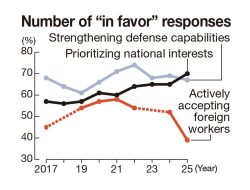
Simon and Schuster, 536pp, Maruzen price: ¥6,160 including tax
November 9, 2021
A bacterium is such a simple organism that its single cell doesn’t even have a nucleus to tidily contain its DNA. But that free-floating genetic material holds the key to an amazing survival technique, called CRISPR, that humans have begun to harness to fight some terrible diseases.
Former Time magazine editor and bestselling biographer Walter Isaacson tells the story in his latest book, “The Code Breaker: Jennifer Doudna, Gene Editing, and the Future of the Human Race.” Isaacson chose Doudna, a biochemistry professor at the University of California at Berkeley, to be his protagonist, but it is a complex story with many key players.
It began in 1986, when Osaka University PhD student Yoshizumi Ishino discovered some odd repeating patterns in bacterial DNA. These later got a closer look from Spanish scientist Francisco Mojica, who named them CRISPR, for “clustered regularly interspaced short palindromic repeats.”
Mojica discovered their function in 2003. He realized that the sequences are bookends for copies of genetic material taken from viruses that had attacked the bacteria in the past. If the virus attacked again, the bacteria could chemically recognize it, and send a strand of RNA to target the matching genetic material. The RNA guides an enzyme to cut the viral DNA or RNA at that point, killing the virus.
In short, bacteria have immune systems. That’s amazing by itself, but it had a monumental implication. If humans could harness bacteria’s ability to target and cut specific genetic sequences, they could use it to edit genes.
That’s what Doudna and her various partners and rivals were aiming for. Much of the book reads like a mild soap opera as the scientists compete to make breakthroughs, race to publish their results and then jostle for credit — and lucrative patents.
Of course, humans are more complex than bacteria. One very basic difference is that our cells are eukaryotic, meaning they do keep their DNA inside a nucleus. To edit human genes, you need to get the CRISPR RNA not only through the outer membrane of a cell, but also through the inner membrane of the cell’s nucleus.
Competing teams of scientists wound up in court over the question of whether techniques for CRISPR gene editing in eukaryotic cells could be called “obvious” — in the particular sense of that word as used in U.S. patent law.
In writing about such disputes, Isaacson had to deal with an issue “that historians know all too well. Almost every person in any saga tends to remember their own role as being a little more important than the other players see it.”
But the importance of the saga itself cannot be denied. In a case of science fiction coming to life, Chinese scientist He Jiankui used CRISPR techniques to try to engineer HIV-resistant babies for HIV-infected parents. He was only partly successful, and wound up with a prison sentence for his efforts.
Doudna was more cautious and fared better. The book ends in October 2020, when she received word that she and her French research partner Emmanuelle Charpentier had won the Nobel Prize in Chemistry.
It was good news for them, but the happiest line in Isaacson’s book is spoken by Victoria Gray, a Mississippi woman who had long lived in the expectation of a premature death due to sickle cell anemia, a debilitating genetic condition. Last year, Gray was apparently cured with an experimental CRISPR treatment, potentially adding decades to her life.
She said, “Now I’ll be able to help my daughters pick out their wedding dresses.”
All because of some odd repeating patterns in bacterial DNA.
— By Tom Baker, Japan News Staff Writer
"Culture" POPULAR ARTICLE
-

Dior, Gucci Adapt Kyoto’s Traditional Textiles for Modern Tastes
-

Event Held at Kyoto State Guest House to Showcase Beauty of Traditional Japan, Includes Crafts, Cuisine, Performances
-

Van Cleef & Arpels Dazzles with Art Deco Artisanry at Tokyo Exhibit
-

Ainu Thanksgiving Festival to Be Held in Tokyo with Performances from Ainu, Other Indigenous Groups
-

Disney’s ‘Twisted-Wonderland’ Animated Series Puts Villains in Spotlight: New Show Features School Inspired by Classic Disney Films
JN ACCESS RANKING
-

Govt Plans to Urge Municipalities to Help Residents Cope with Rising Prices
-

Japan Resumes Scallop Exports to China
-

Japan Prime Minister Takaichi Vows to Have Country Exit Deflation, Closely Monitor Economic Indicators
-

Japan to Charge Foreigners More for Residence Permits, Looking to Align with Western Countries
-

JR East Suica’s Penguin to Retire at End of FY2026; Baton to be Passed to New Character























